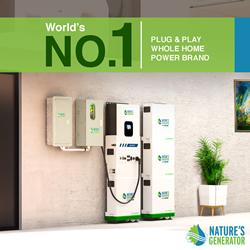Electric Vehicle Battery Market is Experiencing Robust Growth
The global electric vehicle battery market is expected to witness strongest growth at a CAGR of 24.68% from 2025 to 2034 and is expected to reach valuation around USD 679.80 billion by 2034.
The electric vehicle (EV) battery market is experiencing robust growth, driven by the rapid adoption of electric vehicles and surging demand for advanced battery technologies. According to the International Energy Agency's (IEA) Global EV Outlook 2023, demand for automotive lithium-ion batteries rose by approximately 65%, from 330 GWh in 2021 to 550 GWh in 2022, largely due to increased electric passenger car sales.
EV Battery Market Trends
1. Rising EV Adoption & Battery Demand
The expanding efforts of major automakers to transition toward electric mobility are significantly boosting battery demand. Government incentives, stricter emission regulations, and increasing consumer interest are encouraging OEMs to accelerate the electrification of their vehicle portfolios, including trucks, buses, and passenger cars.
2. Growth in Battery Swapping Technology
Innovations in EV battery-swapping infrastructure are opening new opportunities. For example, in October 2021, Gogoro Inc. launched its battery-swapping service in China, partnering with major local manufacturers Dachangjiang (DCJ) and Yadea under the brand Huan Huan, starting in Hangzhou and expanding to additional cities.
3. Strategic Collaborations and Net-Zero Goals
Battery manufacturers are forging partnerships with e-mobility companies and energy providers to improve battery efficiency, life span, and sustainability. These efforts aim to reduce electronic waste and carbon footprints while aligning with global net-zero emission targets.
4. Surge in Automotive Production
Automotive production is on the rise in countries like China, Germany, Japan, South Korea, Mexico, and India, further fueling demand for EV batteries. Simultaneously, governments are investing heavily in EV charging infrastructure, supporting the widespread adoption of electric mobility.
Get sample copy@ https://www.cervicornconsulting.com/sample/2370
EV Battery Market Dynamics
Driver: Technological Advancements
Ongoing improvements in battery chemistries, particularly in high-nickel NMC and LFP variants, are boosting energy density and reducing costs. Technologies like cell-to-pack (e.g., BYD's Blade Battery) and solid-state batteries are setting new benchmarks in safety, range, and charging speed. OEMs such as Toyota, BMW, Stellantis, and Samsung SDI are investing heavily in next-generation batteries, aiming for commercialization between 2027 and 2029.
Restraint: Rise of Alternative Fuels
Alternative clean energy technologies—particularly hydrogen fuel cells and ethanol-powered flex-fuel vehicles—pose a potential challenge to EV battery demand. Notable milestones include HORIBA India's hydrogen internal combustion engine testbed and Triton EV's launch of a hydrogen engine in 2024. Although these solutions offer lower battery reliance, infrastructure limitations and sustainability concerns, especially around ethanol, may temper their impact.
Opportunity: Solid-State Battery Breakthroughs
Solid-state batteries offer a compelling growth opportunity due to their higher energy density, enhanced safety, and faster charging capabilities. Recent advancements include:
- Honda's all-solid-state battery production line (Nov 2024)
- Microvast Holdings achieving 400+ Wh/kg energy density (Jan 2025)
- Toyota and Nissan's production goals set between 2027-2029
- Mercedes-Benz collaborating with Factorial Energy on solid-state innovations
These developments underscore the potential of solid-state technologies to redefine EV performance and safety standards.
Challenge: Lithium Shortages
The growing demand for lithium is creating supply chain constraints. Global production (~80,000 tons/year) is struggling to keep pace with surging EV demand. Countries without domestic lithium reserves—like Denmark, Singapore, and the Netherlands—face heightened vulnerability. While new reserves have been discovered in India's Jammu & Kashmir and Rajasthan, a lithium supply-demand imbalance is projected by 2025-2026, likely driving up prices and affecting battery production costs.
Battery Type Insights
Lithium-Ion Batteries: In 2024, lithium-ion batteries held over 64.93% market share and are projected to continue leading due to their:
- High energy density
- Fast charging (1-3 hours)
- Lightweight and compact structure
Their advantages over traditional lead-acid batteries have made them the preferred choice among EV manufacturers.
Other Battery Types (Solid-State, NiMH, Sodium-Ion): This segment is anticipated to grow rapidly as OEMs shift focus toward solid-state battery R&D. For instance, Nissan is expected to launch its first EV with solid-state batteries by 2028, with pilot production beginning as early as 2025.
Propulsion Type Insights
Battery Electric Vehicles (BEVs): BEVs accounted for more than 71% of global revenue in 2024 and are projected to grow at the highest CAGR. They feature:
- Fully electric drivetrains
- Rechargeable battery packs
- Zero-emission operation
Government support for net-zero policies and consumer preference for cleaner technologies are driving BEV demand.
Plug-in Hybrid Electric Vehicles (PHEVs): PHEVs, which combine batteries with internal combustion engines, are growing steadily across light and medium-duty commercial segments. They offer flexibility in fuel use and are increasingly adopted in buses, trucks, and utility vehicles.
Vehicle Type Insights
Passenger Cars: Passenger EVs, including sedans, hatchbacks, and SUVs, held over 40% of the market in 2024. According to the IEA, over 10 million electric passenger cars were sold in 2022, with continued momentum in 2023, as Q1 sales exceeded 2.3 million units, marking a 25% YoY increase.
Two-Wheelers: This segment is expected to grow at the highest CAGR, especially in markets like India, where two-wheelers dominate. Government subsidies and local manufacturing initiatives are accelerating electrification in this category.
Commercial Light-Duty Vehicles: Electric LCVs are also gaining ground, with global sales increasing by 90% in 2022 to over 310,000 units, driven by last-mile delivery and logistics sector electrification.
EV Battery Market Regional Insights
Asia Pacific
- Market share (2024): Over 50.80%
- Growth outlook: Fastest CAGR globally
The region, led by China, India, and South Korea, dominates due to lower production costs and high domestic demand. China is also home to industry leaders such as CATL, BYD, LG Energy Solution, Samsung SDI, and Panasonic.
Europe & North America
These regions are seeing strong demand driven by stringent emissions regulations and growing EV adoption. Countries like Germany and the U.S. are major manufacturing hubs, supported by OEMs such as Tesla, Ford, and BMW. Competitive innovation is pushing companies to deliver safer, higher-performing, and cost-effective battery solutions.
Get full access of report@ https://www.cervicornconsulting.com/buy-now/2370
Ask here for Electric Vehicle Battery Industry research study sales@cervicornconsulting.com
Featured Product

